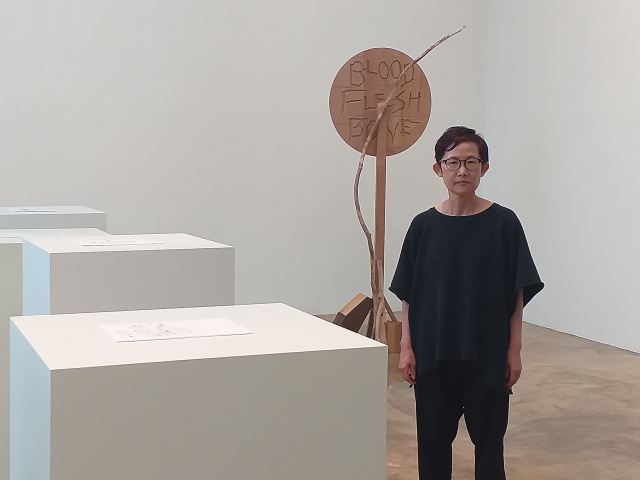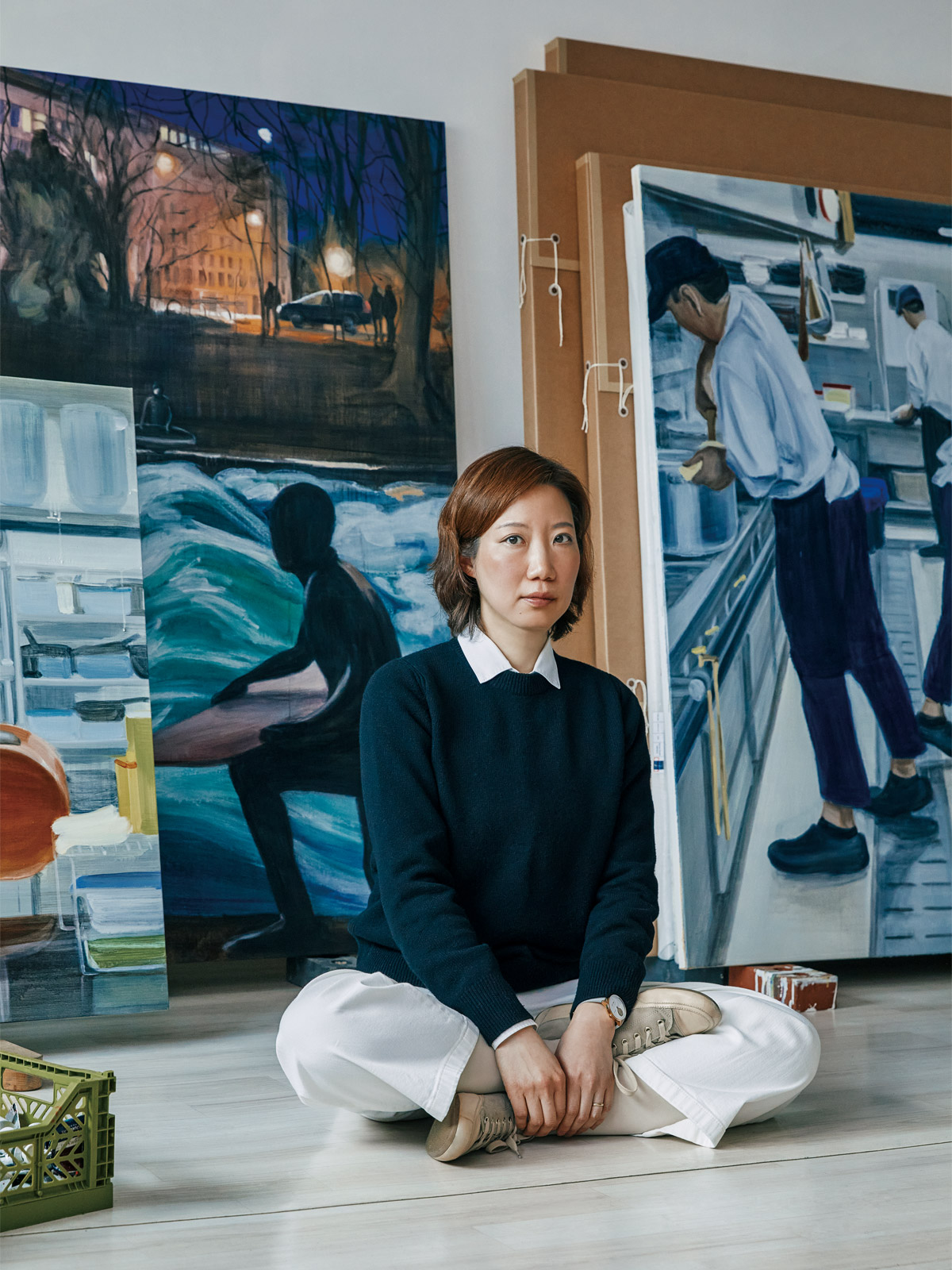Playing a leading role in the establishment of “Korean Contemporary Art” as a new category of contemporary art in the 1990s, sculptor Chung Seoyoung (b. 1964) has been addressing fundamental questions concerning sculpture itself by incorporating the unrealistic gaps in the rapidly changing atmosphere of Korean society into her sculptures. In particular, the artist has garnered attention for her practice of reassembling and transforming everyday commodities found in industrialized societies, such as Styrofoam, plastic, plywood, and sponges, into a sculptural state.
To date, Chung continues to experiment with sculpture in a variety of media and fields, including drawing, sound, video, and performance.
 Chung Seoyoung, Ghost, Wave, Fire, 1998 ©Chung Seoyoung
Chung Seoyoung, Ghost, Wave, Fire, 1998 ©Chung SeoyoungChung takes industrial materials that are commonly found in everyday life and sculpts them without processing or with minimal processing to utilize their original functional characteristics. For example, her early work -Awe (1996) is made of linoleum, an industrial material commonly used in Korean homes at the time, and used as a canvas in its original state.
On the plates, the spoken word “awe” is written in cursive script, which is often used to fill in the gaps in speech in situations that are difficult to describe accurately. By bringing objects out of their traditional use and into new and unfamiliar contexts, and by visually representing the semantic gap of “-awe,” the artist reveals the non-standard and open possibilities of objects and language.
In Ghost, Wave, Fire (1996, 1998), for example, a single abstract form becomes a ghost, a wave, or a fire. Through the sculpture of abstract forms, the artist projects the multiple and indeterminate nature of language.
The moment the viewer recognizes the abstract form as a wave, it becomes a wave sculpture, but the moment the viewer recognizes it as fire, it transforms into a fire sculpture. By sculpting the directive relationship between objects and language or unfamiliar situations in the form of sculpture, Chung invites the viewer to experience these sculptural moments directly.
 Chung Seoyoung, Lookout, 1999 ©Chung Seoyoung
Chung Seoyoung, Lookout, 1999 ©Chung SeoyoungLookout is a representative work in the artist’s oeuvre, in which she is constantly thinking about and shaping new ways of perceiving things. The work began when the artist saw an image of a small, fingernail-sized observatory on a postcard from a friend traveling abroad and wondered how to turn it into a real experience.
For this purpose, the artist used wood plywood and glass to reconcile and consider the perceptual distance between the object and ‘herself’, and realized it as a sculpture that is neither the size of the hand nor the actual observatory, but a certain distance from the artist’s body.
 Chung Seoyoung, Athletic Flower Arrangement, 1999 ©Chung Seoyoung
Chung Seoyoung, Athletic Flower Arrangement, 1999 ©Chung SeoyoungIn the 1990s, when multimedia and conceptual site-specific installations proliferated internationally, Chung immersed herself in the sculptural dimension, capturing the sculptural moment when unrelated elements, such as objects and language, come together to form a single sculpture, and expanding the definition of ‘sculpture’ more broadly.
In addition, the first generation of alternative spaces in Korea, such as Art Space Pool and Alternative Space LOOP, which emerged at that time, began to showcase contemporary artistic experiments by young artists in the Korean art scene, and Chung participated in both spaces’ exhibitions, playing a key role in driving the contemporaneity of Korean contemporary sculpture.
In the opening exhibition of Art Space Pool, Chung presented her sculpture Athletic Flower Arrangement, which uses industrial materials such as zinc, aluminum, and wood to arrange boxing gloves into a flower arrangement, creating an unfamiliar impression. By superimposing and visualizing unfamiliar elements that are not easily connected to our common perception, she creates a gap in our perception and invites us to a new sculptural moment.
 Chung Seoyoung, A New Life, 2003 ©Chung Seoyoung
Chung Seoyoung, A New Life, 2003 ©Chung SeoyoungChung was selected as the representative artist for the Korean Pavilion at the 50th Venice Biennale in 2003. At that time, the artist discovered that there was a hidden doorway in the wall of the Korean Pavilion that led to the backyard, and presented A New Life, a work that began with the discovery and opening of the doorway. She also presented A New Pillar, in which a pillar in the exhibition hall was hidden inside a fake pillar, bringing the space of the Korean Pavilion into the center of her work and expanding the environment into a sculpture.
 Chung Seoyoung, The Adventure of Mr. Kim and Mr. Lee, 2010 ©Chung Seoyoung
Chung Seoyoung, The Adventure of Mr. Kim and Mr. Lee, 2010 ©Chung SeoyoungWhile the artist’s work in the 2000s focused on the sculptural dimension, the performance The Adventure of Mr. Kim and Mr. Lee, presented at LIG Art Hall in 2010, focuses on the performativity of sculpture. The work, which originated as a drawing and installation, features nine performers and a dog, who remain motionless for the entire two-hour performance, with only the dog and its owner wandering around them.
The audience wanders through the theater listening to recorded sounds through headsets. This is a work that experiments anew with the artist’s previous explorations of language and objects, the experience of strangeness in the situations we experience, and the fragmentary moments that arise through the deviations of reality and the gaps in the system, and involves the audience in the performance.
Through these various mediums, Chung has presented works that transform everyday objects, language, and even situations that contain contemporaneity into new sculptural contexts. Recently, the artist has been working on the collective memory inherent in objects. In an interview in conjunction with her solo exhibition “What I Saw Today” (Seoul Museum of Art, 2022), the artist described the “sculptural moment” she has been immersed in as follows.
“In the process of being molded into a single shape, various elements such as thoughts, feelings, and situations change and influence each other, and then suddenly appear in a relationship. That moment is the ‘sculptural moment’.”

Artist Chung Seoyoung ©Barakat Contemporary
Chung Seoyoung studied sculpture at Seoul National University and the State Academy of Fine Arts in Stuttgart and lives and works in Seoul. She was a representative artist for the Korean Pavilion at the 50th Venice Biennale and has held solo exhibitions at Portikus Frankfurt, Germany; Art Sonje Center, Seoul, Korea; Atelier Hermès, Seoul, Korea; and the Ilmin Museum of Art, Seoul, Korea . She has also participated in group exhibitions at the 4th and 7th Gwangju Biennale, Korea; Plateau, Seoul, Korea; The National Museum of Modern and Contemporary Art, Seoul, Korea; the Seoul Mediacity Biennale, Korea; Shiseido Gallery, Tokyo, Japan; Taipei Fine Arts Museum, Taiwan; and the Hong Kong Arts Centre.
In 2024, she held her solo exhibition at the Tina Kim Gallery in New York. She has been honored with the Kim Se-jung Sculpture Award, artist support from the state of Baden-Württemberg, and arts foundation support, and a number of her works are included in the collections of various public and national museums and institutions in South Korea, including the National Museum of Modern and Contemporary Art, Seoul Museum of Art, Gyeonggi Museum of Art, and Art Sonje Center.


















